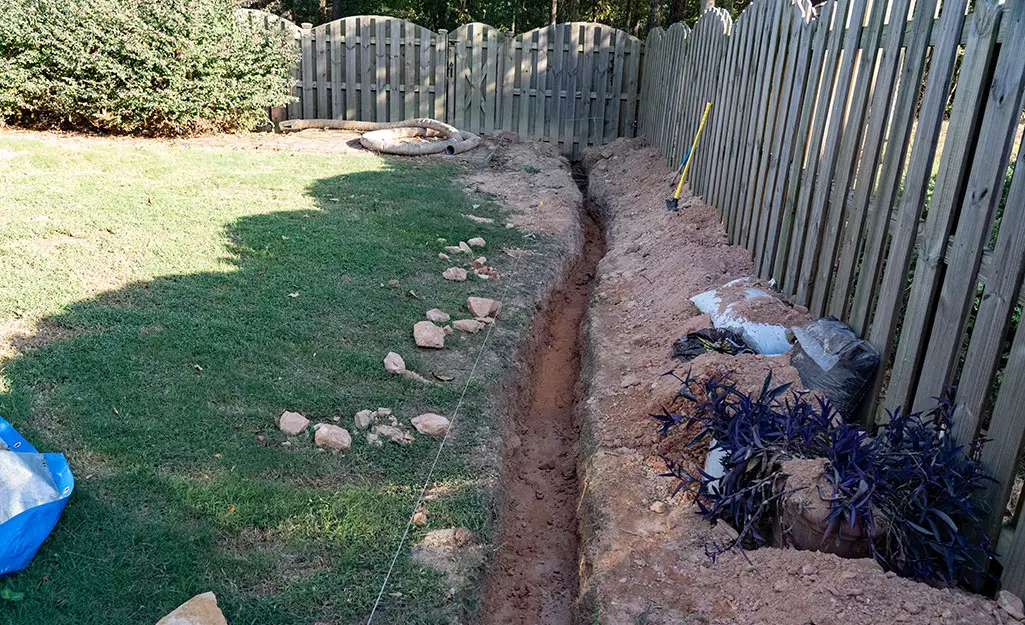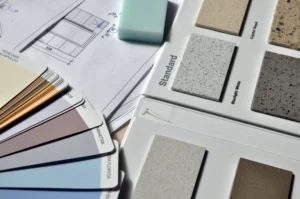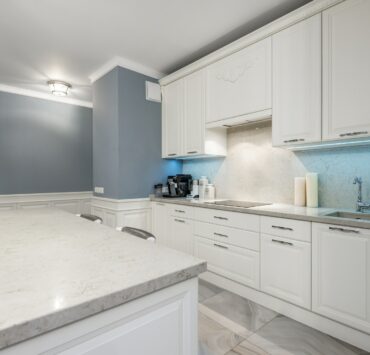The term “French drain” refers to a ditch on a property, typically in the backyard, that keeps rainwater from accumulating close to the home. This can stop water damage and foundation concerns. Want to know more about French drains? Dive deeper into the articles to know all that you need to.
What is a French Drain?
A French drain is a type of water drainage system that diverts water from a building’s foundation using a pipe and a gravel-lined ditch. Stormwater, groundwater, and drainage issues may all be managed with French drains.
In regions where it might harm the foundation of the building, basement, retaining walls, landscaping, and hardscaping areas, excess water is prevented from accumulating after heavy rain using the French drain system.
How Does a French Drain Work?
French drain pipes handle surface water and function much like a gutter that collects rain as it falls from the roof. Imagine water that tends to collect in a specific low area near your home after a downpour. That issue might be solved by using a French drain to reroute the flow of water.
Basements that let water into the structure can also be fixed using a French drain. Water pushes up against the foundation in such “damp” basements and eventually seeps through.
However, water close to the foundation may be diverted and sent away with the help of a French drain before it even enters the crawlspace. You might need to install a French drain surrounding your home if water keeps getting into your basement despite what seems like adequate exterior drainage.
In order to transport water from the inside to the exterior, setup involves excavating a ditch in the ground along the structure’s perimeter, placing piping in the ditch, and installing a sump pump.
How to Install a French Drain?
Using pierced drainage pipes, which enable water to enter or depart through tiny holes along the pipe, is the ideal method for building French drains.
There may be rings or slots in the perforations. But since they tend to lessen the quantity of small soil particles that enter the pipe, slotted pipes are preferable over pipes with tiny round pores. Various steps to install a French Drain are:
Choose a Location for Rerouting and Drainage
Find the yard’s proper location for the rerouting of any excess water. Select a site where the water flow won’t have an impact on nearby homes.
Choose a path that is gradually sloping downward, at least one meter away from walls or fences, and free of any obstacles like posts, trees, or plants.
Make a Trench and Fill it with Gravel
Using the spray paint markers as a guide, dig a 6 ” deep, broad trench that is no deeper than the closest foundation. Remember that proper trenches should be laid horizontally across slopes and parallel to structures. After the trench is dug, include a 3 ” gravelly bottom layer.
Include Fabric Lining
With a layer of gravel on top, line the full length of the trench with landscape fabric, leaving about 10″ of extra fabric on each side.
Place a Drain Pipe
Place a drain pipe on top of the cloth liner, then cover the pipe entirely with gravel. Leave about 5″ of space between the surface of the gravel and the ground.
Fold Over Extra Lining Fabric
Overlap the extra cloth with the gravel. This will aid in safeguarding of the insulated drain pipe.
Cover and Fill Trench
Fill the trench with sand and dirt using a shovel. Put grass over the sand and topsoil, then surround the drain pipe’s open end with a bed of stones. Along the perimeter of your footing, dig a trench. The ditch must be at least 2 feet wide and can range in depth from 2 feet for just a slab-on-grade structure to 6 feet for a basement.
Place the pipe on the untouched ground. The pipe must constantly slope from a higher beginning height to a lower ending elevation so that gravity may drive the water out. To guarantee that water is channeled away from the home’s walls, the grade should constantly slope away from the property.
At least 12 inches of cleaned gravel should be placed over the pipe and to keep any dirt from clogging the pipe, spread filter cloth over the gravel. Restore the foundation’s grade height by backfilling it with top soil.
How to Build a French Drain
Building a French Drain requires you to follow some very basic steps. These are:
- The most labor-intensive part of creating a French drain is digging the trench, despite it being the least difficult. If you can, ask a relative, friend, or neighbor for assistance.
- You must line the trench with the permeable landscaping fabric when you have excavated it.
- Over the landscaping fabric, tamp down about 2 or 3 inches of gravel all along the trench’s bottom.
- In the trench, above the gravel, insert the perforated drain pipe. For the best drainage, ensure the drainage holes are pointed downward.
- Add extra gravel by shoveling it over the pipe until there are 3 to 5 inches of space between it and the head of the trench.
- With the earth that was moved, finish the trench. You are now free to complete the trench anyway you choose.
Is it Advisable to DIY French Drain?
You may create a French drain by yourself, but be aware that it will take a lot of work. Digging will take up the most of your time, but you can hire a trencher to speed up and simplify the process. It takes power and time to fill the trench with gravel.
If a truck can pull up directly next to the trench, it will be simpler to unload the gravel there. The materials you select and the depth of the drain will determine the precise cost of your project.
How Much Does it Cost to Build a French Drain?
A foundation’s structural integrity may be harmed by standing water in or near the outside of a basement or crawl space. A wet basement may ruin belongings and encourage the spread of mold.
Many homes choose to install a French drain as the solution, and the cost of a French drain installation may range from as little as $500 for repair work to $18,000 for a comprehensive system. On average, homeowners will shell out $5,000.
Building French Drain Around Foundation
Basements and water don’t go along. Basements may flood, mold can grow, and these problems are expensive to fix. If not destroyed, anything kept in the basement is at the very least useless till the water dries out.
Asthmatics and allergy sufferers spend more money on medications at the doctor’s office, which has a significantly larger cost to the family’s health. French drains should be installed around your foundations for this reason.
In the end, doing it yourselfers shouldn’t attempt this. The task should be carried out by technicians and a waterproofing professional who are appropriately qualified. A homeowner might not be aware that there is piping with fabric already wrapped around it as an alternative to landscape cloth to prevent dirt and roots out of the piping. It’s possible that a homeowner is unaware that hiring a trench digger is a possibility.
Drainage pipes require a cleanout, much like sewage systems do. Homeowners might not be aware that it would be a good idea to install a cleanup somewhere along the trench above ground, just in case roots or another issue arises.
French Drain for Septic Tanks
The liquid overflows via an output pipe into a dispersion chamber, where it is routed into the septic field. The particles sink to the bottom, the scum rises to the top, and the liquid floats to the top.
The septic field is a method of disposing of effluent water in which the liquid is distributed across a field of soft sand using perforated pipes.
Based on the soil permeability and the local municipality regulations, brick constructed septic tanks and French drains are typical on most agricultural properties. The basic idea of waste treatment is the basis for various variations in systems like septic tanks and French drains.
How to Clean a French Drain?
There are a few steps using which you can clean a French Drain. Some of these are:
Rent a Sewage Snake that is Electric
Rent an electric sewage snake (or auger), a motorized loop of wire with a two-pronged cutting blade at its tip, to clear your French drain. To evaluate pricing, give 2 or 3 rental companies a call. A half-day rental should cost at least $65 in total. Choose a machine with 34-inch cable and one of the 50-foot or 100-foot models.
Be Ready for Some Hard Lifting
The auger is too heavy to be placed in a vehicle trunk, so if you don’t own a truck, or SUV, rent one or ask a buddy to help you with it. To transport the machine once you reach home, seek the aid of a family friend, neighbor, or colleague. Ask a rental business employee to assist you in lifting the equipment into the car. Use a ladder to gently help the snake out of the car if you are relocating it on your own.
Insert the Cable in the Drain
Identify the French drain’s entry. Detach the gutter downspout if your French drain is attached to it before moving forward. Start the auger, then insert the cable gradually.
When You Encounter Opposition, Stop
Stop putting the cable down the drain when it runs into resistance and pull it back just enough to release the cutter. Again, gently slide it forward. Either a barrier will force the cable to spin, enabling the cutter tip to pass through the impediment, or the cable may make its way around the curve.
If You Get Significant Blockages, Completely Remove the Cable
If the cable runs into a significant obstruction that it is unable to completely clear, gently pull it out using the reverse button on the snake actuator. As the cable recoils, clean up the cable with a damp cloth to eliminate buildup. Turn off the device once the cable is completely out, then clean the cutter off of any debris.
Once the Drain is Clear, Repeat the Procedure
Until all obstacles are removed, keep feeding the cable down the drain. If significant obstructions are removed, debris and accumulated water may flow outside the pipe along with them. To effectively unclog and clean a French drain, you need to repeat the procedure at least twice or three times.
Drain Using a Hose
After using the auger to snake the drain, insert a garden hose into it and turn it on. Allow additional debris to be flushed away by the water. Inserting the hose into the sewer along with the auger will allow you to further clean the area by clearing the cable while performing one more snaking. Until the water is clear, let the water run for five minutes.
Conclusion
All in all, French Drain is pretty useful when it comes to draining water and keeping your foundation as well as basement dry. Installing, building, and cleaning the French drain isn’t a very difficult job.








